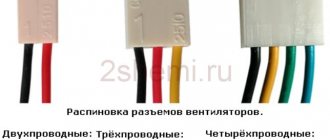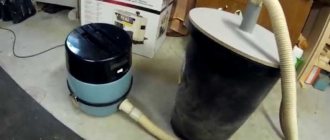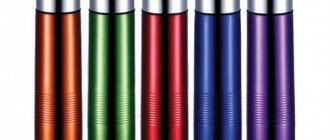→ Natural gas
There are different situations in life. If you suddenly need to use a mini vacuum cleaner, you can save on the purchase and make it yourself.
1. Trace the label along the top and bottom lines. Cut out the part of the bottle where the label was marked.
2. Take an old empty can or tin, remove the bottom and top, then cut down the middle to make a rectangular sheet.
3. Measure and cut a circle from the tin according to the diameter of the bottle.
4. Leaving a place in the middle for a small motor, draw a tin circle and make cuts to make 8 sectors. Each of them needs to be slightly bent. Make a small hole in the center.
5. Now attach the motor to the resulting improvised fan.
6. Using a drill and a large drill bit, make 3 rows of holes at the bottom of the bottle.
7. Glue the cap from another bottle to the motor, after threading the wires from the motor into the hole on the side.
8. Place the fan inside the bottle and glue it to the bottom. Glue the seal to the top of the bottle on the inside.
9. Make a ring from wire with such a diameter that it fits into the bottle and can be placed tightly on top of the seal. Glue a circle of thin fabric onto the ring.
10. Place the ring in the bottle on the seal and tightly close the structure with the top of the bottle.
A low-power centrifugal fan will be of little use. Even quiet hoods are equipped with commutator motors that make a lot of noise. If the fact doesn’t frighten you, let’s proceed to choosing funds. We'll show you how to make a centrifugal fan with your own hands from scrap items. If in a typical axial fan the motor and impeller are important, here, in addition to everything else, the housing is added. Let's try to assemble a centrifugal fan ourselves.
How to make a detergent?
Using the instructions, you can make a washing device from a simple vacuum cleaner. Usually people use a washing machine very rarely. This device is intended for general cleaning of the house or when you need to wash away dirty spots.
The step-by-step instructions for creating the device are as follows.
- Where there is air flow, you need to fix the water filter. The following materials are needed for the filter: a container, an angle, a short pipe for sewage, a corrugation with a diameter suitable for the pipe. A hose from an old vacuum cleaner is suitable as a corrugation. Since the hose is very soft, it will roll up well.
- It is necessary to measure the diameter of the place where you need to insert the nozzle and extension tubes, and purchase an angle that can fit this diameter. Then you need to saw off the tube so that it cannot reach the bottom.
- Using a knife, you need to cut round holes on the lid. The diameter of the holes must be even and suitable for the tube.
- Then tubes should be inserted around the perimeter and reinforced with a glue gun.
- After this, you need to make a fabric filter for a short tube. Such a filter will prevent water drops from entering the vacuum cleaner, since the fabric is a reliable material. Using Chinese electrical tape, you need to wrap this fabric around plastic and pull it tightly.
- Next, take the hose from the vacuum cleaner and insert it into the short tube, and then attach the nozzle to it. Using electrical tape, these connections must be sealed.
- Then you need to tightly close the lid of the bucket and clean the house. As a result of cleaning, all the water will be located in the tank. And the filter will remain dry, there will only be dirt from cleaning on it. The pipe that was inserted into the vacuum cleaner will also be dry.
What is a centrifugal fan
A centrifugal fan is used as a duct fan. To make things easier, the vacuum cleaner contains what looks like a duct fan. Now think:
- The dust is sucked up by a hose.
- Passes into the bag (tank, compartment).
- Passes filtration.
- The engine passes.
- It is ejected from the back of the case.
What it does is that there is a centrifugal fan inside, formed by a drum (squirrel cage) mounted on the motor shaft. This is not enough. The engine with the impeller is enclosed in a sealed housing, through the channels of which the air escapes to the outside. Without a tight casing, the meaning of the centrifugal fan will be lost. Here's the main difference. Unlike axial fans, which often serve for personal needs, centrifugal fans are used in the economic sphere: room ventilation, cleaning, air purification. To understand how to make a centrifugal fan, let's study the principle of operation of the device.
Do-it-yourself chip extractor
The chip ejector from a vacuum cleaner can be called the most inexpensive option of all existing solutions. Of course, a household vacuum cleaner by itself will not bring any benefit to your workshop. The main reason for its uselessness is the small volume of the bag. That is why an additional exhaust system must be installed between the vacuum cleaner and the machine, which consists of a cyclone and a large tank for collecting sawdust.
At home, the chip pump has two main modules:
Using a vacuum cleaner, a vacuum is formed in the cyclone chamber. Due to the difference in pressure inside and outside the unit, sawdust, along with air and dust, enters the internal cavity of the cyclone. The forces of inertia and gravity act there, as a result of which mechanical suspensions are separated from the air flow and settle in the lower container.
The cyclone can be created in the form of a lid mounted on top of the storage tank. These modules can also be combined into one. First you need to buy a tank of suitable size. For example, a 65 liter plastic barrel is perfect.
Additional materials:
- screws, washers and nuts are needed to secure the inlet pipe
- piece of sewer pipe with cuffs
- transition coupling, again from the sewer pipe, to the suction pipe of the unit
- gun with assembly glue.
When everything is purchased and prepared, you can start working. First of all, in the side of the barrel you need to make a hole for the inlet pipe, which should be placed tangentially to the body. It should be installed at the top of a plastic barrel to obtain the highest degree of purification. Be sure to fill the gaps between the pipe and the walls of the barrel with mounting sealant.
After this, you need to make a hole in the lid, insert the adapter coupling there and carefully seal all the cracks around the pipe. The vacuum cleaner is connected to the upper hole, and the pipe, which will remove chips from the machine, is inserted into the side pipe.
However, the cyclone will still not be able to contain a small percentage of wood dust. And in order to achieve the maximum degree of cleaning, it is worth equipping the unit with a fine filter. As an option, a fabric filter is suitable, which is attached to a frame to the top cover of the cyclone and covered with dense material (for example, tarpaulin). The task of the cyclone is to remove sawdust and dust from the working area.
It is better to buy hoses that connect to the chip extractor from a vacuum cleaner. Lay a plastic pipeline with smooth inner walls along the wall, which will become the connecting element between the machine and the suction pipe of the cyclone.
Static electricity generated during the movement of sawdust through a plastic pipe can be dangerous: sawdust sticks to the walls of the pipeline, fire of wood dust.
To create a structure that will fully comply with fire safety rules, you need to use corrugated material with a built-in metal conductor as a sawdust pipe. If you connect such a system to a ground loop, you can avoid problems during operation.
Exhaust elements can be products made of plastic, plywood and other suitable materials.
Systems based on a household vacuum cleaner are characterized by low productivity. Such devices can only serve one machine. It turns out that if you have several machines, then you will need to connect the suction pipe to them in turn.
The entire structure can be installed on a single wheelbase, which will significantly increase the level of mobility of the chip ejector.
ATTENTION TO THOSE WHO WANT TO REGISTER ON THE FORUM. Problem activating your account? Write to (ignel(gav)mail.ru, ICQ 50389649), indicating your nickname and the address from which you registered. Don’t forget to look at the forum rules
Ignorance of the rules does not exempt you from responsibility! Don't forget to look at the TB Section. Knowing the rules can save lives. Have questions about using the forum? Look for answers in the FAQ (FAQ). There is a lot of useful information there. Looking for interesting materials? Guide to master classes from our forum members
- Artisan »
- Tools, fixtures and workshop »
- Homemade (Moderator: SergZH) »
- Topic: Homemade chip sucker or my answer to the bourgeoisie
Author Topic: Homemade chip sucker or my answer to the bourgeoisie (Read 298603 times)
0 Users and 1 Guest are viewing this topic.
Making a cyclone for a vacuum cleaner with your own hands will not be difficult if you have experience working with tools. The installation, called a cyclone, acts as an effective air purifier from small debris and dust. Many woodworking machines are equipped with nozzles for chip removal. A homemade cyclone is connected to this pipe.
Classification of devices
A vacuum cleaner for treating nails is a compact piece of equipment whose operation is based on drawing foreign particles into a special reservoir (replaceable bag). The device has high power and average noise level. The dust collector is most often made of plastic; it may have a built-in portable design.
Let's look at the main types of vacuum cleaners for manicure salons:
Desktop
A budget version of the dust collector, it has small dimensions and is most often designed as a support stand for clients’ hands. Ideal for mobile nail modeling, because... It is light in weight, has acceptable dimensions, and is convenient to transport. Additional options for models may include the ability to set a timer to start or turn off, the presence of backlighting, and a velor mat for the hand.
Mini device
Due to its miniature size, the vacuum cleaner can be used as an overlay for equipment for modeling nail plates. It is possible to attach it to a master's chair, lighting fixture, or other pieces of furniture. For example, a pedicure machine with a vacuum cleaner is very convenient to use.
Built-in equipment
The hood is a stationary structure installed directly on the manicure table. A distinctive feature of such a hood is its high power, durability, and safety. In order to optimize the work of a specialist, the equipment is installed under the surface of the tabletop through a special hole and decorated with a grid.
Products from Italian and American companies with additional options have become popular and in demand models of built-in hoods. The device can operate without interruption for several hours and has a long warranty period from the manufacturer.
The disadvantage of this vacuum cleaner model is the need to destroy the integrity of the manicure table for a special installation, the high price and non-transportability. Stationary equipment does not protect the cosmetologist and the client from chemical compounds released during pedicure, since work cannot be carried out directly above the vacuum cleaner.
Model with filter
A variety of this hood is available in both stationary and mobile designs. The main feature of this type of vacuum cleaner is the presence of a filtration unit. The dust collector will become an indispensable assistant for a cosmetologist who serves a large flow of clients per day.
Floor vacuum cleaner
The hood has a stationary design, has high power, and is capable of purifying the air in the room from potential pollution in an extremely short time. The dust collector housing is quite large in size and can be installed on any part of the floor of the room. The main ventilation structure is located inside the device, and an additional exhaust hose is supplied to the master’s working surface.
The vacuum cleaner is perfect for any type of nail treatment and has high power. The negative aspects of this model are high energy consumption, large size and inconvenient placement.
Screw option
A device with a blade has drawbacks, and the main one is the waste of time and effort to remove the layer of snow picked up by the blade. Often it is left right next to the road, creating high snowdrifts, which is not always acceptable.
The version of the snow blower with an auger will allow you to get rid of even roadside sediment, because its design provides for the throwing of the captured mass over a distance of several meters. This will help clear the yard or street completely, leaving the piles next to the fence.
This option is welded or screwed from the front to a frame with wheels, which can be removed from an old wheelbarrow, for example.
Another design is a wheelless version, controlled by a tube. The body is mounted on a frame made of angles, from the bottom of which skis are screwed.
Main components and materials of both options:
- box - welded from sheets of metal;
- central shaft - is a ¾-2 inch pipe;
- gripper (scapula) - iron plates or pieces of channel;
- supporting elements;
- auger - made of rings or tape;
- motorcycle sprocket;
- ski made of plates or pipes;
- frame made of corners;
- bearings;
- a pipe for throwing out snow - you can take it from the stove.
Screw assembly sequence:
- 4 rings and 6 support plates are cut from roofing sheets or other metal.
- Six strips are placed on the shaft and welded to it at an angle of 90°. Then the sprocket is strengthened and the bearings are pressed in.
- Two blades made of plates are inserted between the middle guides. They are welded to the shaft and to the supporting elements. If pieces of channel bars are used as gripper blades, they are rotated 180° relative to each other.
- The rings are cut, bent and welded so that two intersecting spirals are obtained.
You can straighten them in two ways:
- Clamp the middle part in a vice, grab one edge with pliers and pull it to the side. Do the same with the other end.
- Weld one edge to the support element at the blade and stretch it.
If the rings are made of thick material and it is difficult to grasp them with pliers, then you can use two clamping devices, such as a vice.
After making the auger, a sheet of metal is laid out and the box is welded. A hole is cut out in its middle part for a pipe to throw out snow. You can make it yourself or use one already prepared from an iron stove. Some craftsmen use plastic ones.
Then a rectangular hole is cut in the body opposite the sprocket to allow the chain to pass through. The box is installed on a frame with runners or wheels and the chainsaw is strengthened.
Preparation
At the very beginning, you should clearly define the goals that your homemade vacuum cleaner will need to accomplish. Some features of its design will depend on this. If we need it, then a battery-powered motor from a children's toy will do just fine. If we are going to make something more serious (for example), then the parts and materials used must be, accordingly, larger and stronger.
You need to be more careful when choosing a motor and a power source for it. Their electrical characteristics must completely match, otherwise problems may arise: one of the two will either burn out or simply not work.
Garden device
For owners of private households with their own yard, the issue of removing leaves and other debris becomes relevant. Garden vacuum cleaners are collected for these purposes.
It is difficult to install a shredder with your own hands. But you can get by by increasing the diameter of the suction tube. The best donor in this case will be an old domestically produced device. A plastic container is installed in a device of this type with a prepared hole of suitable diameter. All that remains is to connect a wider corrugation to the container with a dense piece of pipe at the other end. A sewer pipe is perfect.
Whatever a homemade construction vacuum cleaner for the home is, it cannot compare with an industrial one, but if necessary, it can become an indispensable assistant for one-time use.
Originally posted 2018-03-28 15:19:32.
General characteristics
In modern times, the demand for manicure services is growing rapidly. During the work of the master, tiny particles of dust are formed that are harmful to human health. According to sanitary and hygienic standards, to keep the workplace clean, the installation of special equipment is required - a vacuum cleaner for manicure. This will prevent harmful chemicals from entering the body and the mucous membranes of the eyes.
Regardless of the type, the device operates thanks to an electric motor that drives the fan blades. As a result, all debris is first drawn into the housing and then into the dust collector.
Important! The dust bag must be cleaned periodically, with the exception of polyethylene options for disposable use, replaced after filling with new ones
Step-by-step production of the Cyclone
Let's look at different options for making a Cyclone for a vacuum cleaner with your own hands from sewer pipes and how to make such a device following step-by-step instructions with drawings and photo examples.
Without cone
For the design of a bucket and sewer pipes you will need:
- oil filter;
- plastic bucket;
- sewer PVC elbows at 45° and 90°.
- pipe with a cross-section of 40 mm and a length of 1 m;
- corrugated pipe 2 m long and 40 mm in diameter.
The design process is as follows:
- We cut a hole in the center of the bucket lid so that a 90° angled plastic pipe fits into it, to which the vacuum cleaner will be connected.
- Seal the cracks with sealant.
- We cut another hole in the side of the bucket and insert a 45° elbow.
- We use corrugation as a connecting element to the elbow.
- We connect the filter outlet to the elbow in the bucket lid.
With cone
To make such a device you need to prepare:
- traffic cone;
- round wooden sticks;
- large capacity;
- plastic elbows with a diameter of 50 mm at 45° and 90°;
- piece of PVC pipe 50 mm;
- corrugated pipe;
- thick plywood;
- fastener
We make the filter this way:
- From plywood we cut out a platform for a cone in the form of a square measuring 40*40 cm and a circle equal to the inner diameter of the cone.
- We fasten the two parts together using self-tapping screws or glue and drill a hole in the center for a 50 mm PVC pipe.
- We make a platform measuring 40x40 cm from plywood and make a hole in the center, the diameter of which should correspond to the diameter of the top of the cone.
- We attach four round sticks to the platform from step 3 and insert the cone tightly.
- We make a hole with a diameter of 50 mm on the side near the base of the cone and insert a pipe into it, coating the seam with sealant.
- We apply the platform from step 2 to the vertical posts and fasten the part with self-tapping screws. Using wooden holders, we secure the pipe entering the lower part of the cone, after which we insert another pipe and an elbow into the hole in the center.
- We install the cone on top of the garbage container, connect the vacuum cleaner pipe and the garbage suction pipe, and check the functionality of the device.
Simple Cyclone
If you need a vacuum cleaner to clean the workplace after working with a CNC router or similar equipment, you can assemble a simple and compact Cyclone from PVC sewer pipes and plastic bottles.
For assembly you will need:
- 2 corrugated hoses for the vacuum cleaner;
- PVC pipes with a diameter of 40 and 100 mm;
- sheet of metal 0.2-0.5 mm thick;
- 2 plastic bottles of 2.5 l and one of 5 l;
- metal scissors;
- electric drill with drills;
- riveter;
- hot glue gun.
We make the filter this way:
- From a pipe with a cross-section of 100 mm, cut an even piece 50 cm long, which will serve as the body of the device.
- We cut two pieces of 40 mm pipe with a length of 40 and 15 cm, after which we draw 3 circles with the inner diameter of the body on a sheet of metal. In the center of these circles we draw more circles with the diameter of a smaller pipe.
- We cut out the metal parts with scissors, then cut them to the middle and cut out the inner circles. Then, using rivets, we connect all the elements together in the form of a spiral, which we put on a 40 mm pipe, evenly distribute the turns and fix them with hot glue.
- We place the spiral in a large pipe and leave a slight protrusion outward.
- In the upper part of the body we make a hole for the suction pipe, clearing off the burrs for a tight fit.
- We place the pipe in the hole, sealing the joint with hot glue.
- From a 5 liter bottle, cut off the top part from which we remove the neck. We adjust the resulting hole to fit a 40 mm pipe, after which we put the part on the body and glue it with hot glue.
- We cut off a large part from a 2.5 liter container and put it on the bottom of the body with obligatory gluing.
- We make a connecting element from two plugs by drilling out the middle. We strengthen the bottle that will be used for garbage using welding electrodes. To do this, glue them around the bottle using tape. We screw the container into place and connect the hoses for suction and outlet.
You should not use corrugated tubes that are too thin, as they will emit a strong whistle during operation.
You can learn more about making a homemade Cyclone from the video.
Backlight for router
A few photos, a little text and a little about the router itself. So, we have: milling cutter “Stavr” MF-12/1800; “charging” at 5 volts DC from an old phone; a switch from a table LED lamp and an LED strip with 5 volt diodes.
The charging board fit into the handle of the router; we had to cut down the internal partitions a little. The power wires are routed through the top cover and soldered to the switch input wires. The button for turning on the backlight is installed in the same handle at the bottom, which is quite convenient and neat.
The LEDs were on an aluminum strip, at first I wanted to unsolder them and transfer them to a homemade board, I tried to warm them up with a hairdryer, helping with a soldering iron, but I couldn’t unsolder a single LED intact. I had to cut off a couple of pieces from the tape, clean up the tracks, cut some, and solder some to each other, because... The LEDs were connected several in series, paralleled them and glued them through thermal tape to the bottom of the router. He fed the food through a hole made nearby. Only a small part of the wire is outside, everything else is inside.
I am very pleased with the result. Because The work is off-site, lighting is often very poor. With backlighting it is much more comfortable and accurate.
A little about the router: pluses - smooth start, speed control, travel along the guides 5cm, good stop-limiter. Three sizes of collets included. Price 4500 or so. Cons: huge play, about 1.5 mm. Set it up, raised it, lowered it, etc. It’s not a fact that it’s at the same point. The guide bites, the router can freeze in the middle, lubricating the guides helped (they are not easy to get to), but sometimes a slight bite still happens. The latch is inconvenient to work with, it has a very long stroke, besides, it does not hold well and the router sometimes spontaneously rises under the influence of springs. Not a very good version of the collet; it only clamps a small section of the shank. The side stop moves away from the platform by about a centimeter, so you can use it when milling material of a smaller thickness by throwing something under the clamps so that the stop stands obliquely and presses against the platform (you can see two thin hexagons in the last photo). There is no clamp on the router that limits the height travel, so fixing it upside down will be quite problematic. The transparent dust extractor, which is installed to connect a vacuum cleaner, blocks almost the entire view of the working area and it was simply impossible to work with it without lighting. The dust exhaust had to be cut down. The inscription “professional” proudly appears on the box of the router. In fact, this is a tool of very low quality, suitable for household work and work with not very good accuracy. Embed hinges, remove edges, etc. If you try and put your hands on the router itself, you can even work with it. That's all.
Source
Difference between wet and dry cyclone
To create a swirling flow, the main requirement is that the air entering the container does not follow the shortest path to the exhaust hole. To do this, the inlet pipe must have a special shape and be directed either to the bottom of the container or tangentially to the walls. Using a similar principle, it is recommended to make the exhaust duct rotary, optimally if it is directed towards the cover of the device. The increase in aerodynamic drag due to pipe bends can be neglected.
As already mentioned, a cyclone filter has the potential to remove liquid waste as well. With liquid, everything is somewhat more complicated: the air in the pipe and cyclone is partially rarefied, which promotes the evaporation of moisture and its breaking into very small droplets. Therefore, the inlet pipe must be located as close as possible to the surface of the water or even lowered under it.
Most washing vacuum cleaners introduce air into the water through a diffuser, so any moisture contained in it is effectively dissolved. However, for greater versatility with a minimum number of alterations, it is not recommended to use such a scheme.
Operating principle of a centrifugal fan
A centrifugal fan operates due to the dynamic characteristics of the flow. Try tying a stone to a thread and twisting it around yourself in a horizontal plane. The hand feels a noticeable tension; if the connection were broken, the projectile would immediately fly out tangentially to the circular path of rotation. Air molecules behave similarly: the wheels on the blades acquire significant speed and, unrestrained by anything, are carried away to the outer perimeter. Then the channel system gives the flow the desired direction. Finally, air enters centrally, usually on the side opposite the engine.
Inside the vacuum cleaner we see a picture:
- Air from the bag (tank, container), cleaned of dust, approaches the engine from the front and enters the center of the drum.
- The molecules, accelerated by the blades to a significant speed, are thrown out. They pass through the channels of the sealed housing, simultaneously cooling the engine, and leave the belly of the vacuum cleaner from the back side.
Design feature: the blades of a centrifugal fan create pressure; if the housing is leaky, the air flow will be disrupted. Therefore, the difficulty for a self-taught master is to create the right conditions.
Good hoods use motors with tangential (centrifugal) type fans. In selected designs, the design surprises with a duet of squirrel cages. In the latter case, a pair of impellers is mounted on either side of the engine on a shaft. Then the air enters from two directions perpendicular to the plane of rotation of the wheels. Thus, the efficiency of the centrifugal fan increases.
Option No. 1 – Use a flat stand
In the first case, in order to make the device ourselves, we will need the following materials:
- a regular laser pointer (shown in the photo above; if you don’t have it lying around from previous years, you can buy it, the price is low);
- bubble building level;
- wooden peg, 1 to 1.3 meters long, 5 to 6 cm in diameter;
- a small piece of rubber;
- a sheet of plywood or board along the length of the level.
Having prepared all the materials, you can proceed to assembling a homemade device. To make it clearer to you how to make a laser level with your own hands, we provide a step-by-step guide:
Prepare the laser pointer. To make the beam brighter and clearer, break through the glass in the nozzle. To do this, cover the nozzle with cardboard and carefully break the glass. We will improve the construction level. You need to attach a pointer to the top of the instrument, for which it is better to use clamps. To be able to slightly adjust the direction of the laser beam in the future, place a piece of rubber between the level and the pointer, as shown in the drawing.
Assembling the stand. First, one of the ends of the bar needs to be sharpened so that it fits well into the soil. After this, you need to assemble a reliable stand from a peg and a sheet of plywood with your own hands, screwing the sheet to the second end of the block with a self-tapping screw
We draw your attention to the fact that the plywood must be screwed strictly perpendicularly, otherwise the accuracy of measurements will leave much to be desired.
That's all the manufacturing instructions. As you can see, it is not difficult to make a simple laser level with your own hands, but the problem is that such a homemade product cannot be installed on a hard surface, for example, a concrete screed. To solve this problem, you can also evenly screw a board from the second end of the peg, which will serve as a stand. In addition, you can make a stand, like a real level, but making a tripod will take more time.
Using such a homemade laser pointer device is not difficult. First, the stand is driven into the ground, after which it is leveled with a bubble level - the bubble should be strictly in the center. Next, you need to turn on the pointer and mark the point projected on the wall with a pencil. After this, the stand carefully rotates along its axis in a horizontal plane to the next mark. The two points are connected to each other and that’s it – the straight line on the wall is ready, you can start installing the electrical wiring!
It should be noted right away that you should not rush and start important marking work from the very beginning. First of all, you must make sure that the homemade product works correctly so that the result does not become disastrous for you. To do this, you need to adjust the homemade laser level (in other words, check the accuracy of the work).
You can make the adjustment yourself like this:
- You need to screw a self-tapping screw no more than 120 mm long into the sheet of plywood on which the level is installed. The head of the screw must coincide with the projecting line of the laser pointer, as shown in the drawing.
- Next, you need to turn on the pointer and point it at one of the walls, then make the appropriate mark with a pencil. The second self-tapping screw must not be completely screwed into this point.
- Now a profile for drywall or any other plank of light weight is carefully installed on the heads of the screws.
- A homemade laser level is installed on the profile and, if required, the bar is aligned in a horizontal plane at the base of the bubble. Alignment must be done by tilting higher/lower the edge of the profile that is located closer to the wall.
- Having leveled the profile, you need to screw a new screw into the wall, if necessary, and then remove the profile.
- In the end, the homemade level is installed on the stand and the pointer is adjusted to a new point (the screw head). Now your device is perfectly level.
With the help of such a homemade laser device, you can independently make horizontal lines to conduct hidden wiring in the house. However, you should not trust the accuracy of the measurements too much, because... This is not a professional tool and the error here is quite high.
Manufacturing of additional filters
The air-drawing action of a household vacuum cleaner creates a different pressure inside the waste container than the pressure outside. In rarefied air, particles of dust and debris fall down under their own weight and the action of inertial forces.
In order for the incoming waste to be divided into small and large fractions, additional filters are needed, which will finally turn the household appliance, practically, into an industrial vacuum cleaner with your own hands.
You can purchase a ready-made oil filter on which small dust particles will settle, or you can make a cyclone filter for a vacuum cleaner with your own hands. It may look like a rubber cap with many small holes, or a fabric product.
The effectiveness of homemade compared to store-bought analogues
Homemade ones cannot compare with professional ones. They differ according to the following criteria:
- engine power;
- suction power;
- volume of the waste collection container;
- noise level;
- air purification;
- availability of additional functions;
- strength and stability of the body.
Compared to the construction version, of course, the homemade version differs in the power of its work. But a homemade vacuum cleaner can handle small shavings and construction dust without any problems. The homemade one is lighter in weight and smaller in size, which will allow you to remove dust from the floor and walls. But the function by which the air is purified is beyond his control.
A DIY construction vacuum cleaner does a good job of collecting concrete, cement dust and sand.
Distinctive features: noise level and energy consumption, does not overheat.
A homemade device creates less noise than purchased equipment and consumes less electricity. The unit can operate for a long time without overheating. For efficient operation, fans should not be connected closely, but at a short distance. Otherwise, the fans will interfere with each other during operation. In the spacer, make movable blades at an angle to allow air flow to pass through.
A homemade vacuum cleaner will be useful for motorists, radio amateurs and any other person for collecting small debris. The basis of the device is a plastic container. An engine from a children's toy is installed inside. The simplest instructions will help you figure out how to make a vacuum cleaner from a bottle with your own hands and put it to work.
Homemade circular saw machine
A do-it-yourself cutting machine made from an angle grinder is not inferior to some factory-made samples. The grinder is a fairly powerful hand-held circular saw.
The grinder-based machine performs precise cuts of lumber and metal profiles. To make it you will need the power tool itself, a welding machine and a metal profile.
Step-by-step instructions for assembling the machine
- Two metal strips are welded to the pipe section, in which mounting holes are drilled.
- Accordingly, two holes are also made in the casing of the angle grinder.
- The strips are bolted to the casing.
- The machine bed is made from a metal sheet with support corners welded to the bottom.
- A vertical section of a corner is attached to the frame by welding, in which a hole is drilled.
- A piece of angle is welded to the lower end of the lever and drilled through along with the pipe.
- The bolt is threaded through the holes and the hinge connection of the vertical post with the lever is tightened with a nut. Additionally, install a lock nut.
- In a vertical position, the angle grinder lever takes a stable position.
- A cut is made at the point where the saw blade comes into contact with the frame so that the blade can completely cut the workpiece.
- The handle of the power tool is moved to the end of the lever.
- As additional devices, a transverse and angular stop are installed on the frame.
If necessary, remove the power tool from the machine and use a circular saw in manual mode.
Homemade bow saw
A bow saw is a convenient tool for cutting tree trunks and lumber. The design of the saw is simple; making a hand tool with your own hands is not difficult. To do this you need to prepare tools and materials:
Tools
- drill;
- hacksaw;
- chisel;
- hammer;
- knife.
Materials
- cord;
- wooden slats 20 x 40 mm;
- cotter pins – 2 pcs.;
- stalk ø 10 mm;
- saw blade;
- stain;
- wood varnish.
Step-by-step instructions for making a bow saw
- The lath is cut into three parts (two vertical side strips and a middle horizontal strip).
- Grooves are made in the side handles using a chisel.
- At the ends of the centerpiece, protrusions for grooves are cut out with a chisel.
- The centerpiece is connected to the side handles.
- Through holes are drilled at the joints. Wooden cotter pins are driven into them.
- Cotter pins form hinge joints. This is necessary for the mobility of the lower ends of the side slats when the canvas is tensioned.
- Cuts are made at the lower ends of the sidewalls - parallel to the middle.
- Short bolts are inserted into the holes of the saw blade and tightened with nuts.
- The blade is inserted into the cuts so that the bolts are on the outside of the structure.
- Circular grooves are cut out at the upper ends of the handles.
- Loops are made at the ends of the double cord, which are placed on the grooves.
- A handle is inserted between the strings of the cord, the long end of which rests on the mullion.
- The saw string is twisted using a handle, achieving the desired degree of tension on the saw blade.
- The wood is covered with stain and two layers of varnish.
- After the varnish has dried, the saw is ready for use.
Will need
- An old hair dryer (with a working motor!).
- Simple switch.
- 9 volt power supply.
- Top half of a plastic bottle (with neck and cap).
- Metal-plastic tube with a diameter of 20 mm (15-20 cm long).
- A small rag bag for the outer diameter of the hair dryer.
- Tools and consumables:
- Secondary glue and soda.
- Soldering iron, with flux and tin.
- Boring machine with cutting disc.
- Stationery knife.
- Scissors.
- Screwdriver.
- Marker.
- Pliers.
Safety precautions when working with machines
A chipper is a dangerous mechanism, so you must be extremely careful when working with it.
Before each start-up, it is necessary to check the condition of the electrical part of the chipper.
At least once a week, you need to check the tightness of all bolts and nuts, including the fastening of knives and bearing yokes.
You should not work with your clothes open or your sleeves unbuttoned, as they could be pulled into the chopper along with the wood. In addition, you should not approach a running unit from the reverse side, especially if the belt drive is not covered with a casing.
Due to the high noise level, working without headphones may damage your hearing.
Selecting consumables
Oddly enough, ordinary sand is not suitable for a sandblasting machine, because its particles are different from each other, and this can negatively affect the final result.
Too large particles in regular sand can cause serious scratches. The solution to this issue is an abrasive mixture, which can be found in almost any specialized store. They may differ in particle shape and size. All this affects the intensity and quality of processing, but it is worth considering that not every mixture is suitable for very soft surfaces.
Hand-cleaned coastal sand can also be used as a mixture.
Currently, it is recommended to move away from previous traditions, because the market offers other, more effective mixtures, and besides, sand is quite dangerous for the human lungs.
In some countries of the European zone, the use of this material is even legally prohibited due to the fact that it can cause harm to humans.
Why is it necessary?
When it comes to purchasing a vacuum cleaner for the salon or personal use, you can’t think about the need. First of all, this is safety: a manicure hood protects the client and the master during the active period of working with the drill
A high-quality model with good power draws in particles of sawed-off polymer, no matter what the nails were covered with
When cutting out nails or removing old coating with a milling cutter, the polymer turns into dust, which floats in a cloud around the table. Sometimes nail art specialists use a gauze bandage in the hope that it will protect the respiratory tract from manicure debris.
Particles of sawdust settle on the clothes of the master and client. Not one reputable salon can afford such oversights. With constant customer service, the specialist’s desktop will be strewn with the remains of the nail plate, acrylic or gel filings.
This device provides safety from the following troubles:
- Allergies.
- Development of respiratory tract disease.
- Particles in the eyes.
- Spread of debris over the entire surface.
- Particles settling on the clothes of the master and client.
The second important point in purchasing a vacuum cleaner for manicure is its main task - collecting garbage. Be that as it may, the quality of the master’s work directly depends on the presence of the unit on the manicure table. The tool sucks up the remains of dead skin, acrylic or polymer particles, leaving the table surface perfectly clean.
Operating principle of a construction vacuum cleaner
Do-it-yourself industrial vacuum cleaner has slightly different technical characteristics. The principle of operation is that, thanks to the pump, the motor creates rarefied air. The air flow with dirt is sucked inside. Using a filter, the air is purified. The operating principle of a construction unit with a cyclone consists of 3 important components
When choosing, pay attention to the power of the work and the motor.
- Engine;
- Pump;
- Filter.
The homemade construction option is distinguished by a multi-level air purification system.
What is the difference between a construction vacuum cleaner and a regular one?
But for occasional work, this design can be slightly modified and improved. The idea belongs to Andrey Shayter.
Before we look at the second design option, ask yourself the question: “What is one of the main differences between household vacuum cleaners and construction vacuum cleaners?”
In domestic models, cooling occurs due to the intake air.
That is, you vacuum the floor, the air sucks in debris. Next, it is filtered and cooled by the engine itself. After which the air is thrown out.
This is where the risk of engine damage comes from. Firstly, when the filter becomes clogged, engine cooling drops sharply.
Secondly, cement dust is 100% not retained in the dust collector, and some of it flies through the windings, along the way removing the varnish insulation like sandpaper. Such dispersed dust kills everything that rubs and rotates.
Adding water to the bottom of the tank doesn't really help. Instead of dust, you will get a lot of dirt, the weight of the bucket, and the filters will still eventually become clogged.
In professional devices, the engine is cooled separately, through special technological holes. Therefore, they are not so afraid of bags completely filled with garbage.
Moreover, they also have automatic cleaning or shaking.
In order to intelligently remake a household model, you will need a little more spare parts than in the first case.
Which to choose?
By studying this article, you will learn how to choose correctly, how to choose a vacuum cleaner for manicure will no longer be a problem. The variety of types, functionality, cost, it is also necessary to take into account the safety for nails, fingers and nail technician tools when choosing a hood. In addition, you can decide whether to buy built-in equipment or not.
Desktop
Externally, it is a small device that is used as a support for the client’s hand, which is doubly good. It is quite quiet in everyday life, so it does not interfere with the conversation while processing nails, and it will be easy for the specialist himself to endure the whole day next to such an assistant. The color scheme of the device presents a rich range, just like the external coverings, but preference is given to soft leather so that a sweaty hand does not slip off. All these coatings are perfectly treated with an antiseptic to maintain hygiene and sterility of the equipment.
It is precisely these vacuum cleaners for manicure that have earned great popularity due to their portability: they are used both in small salons and for visiting clients at home. The devices can be wider, where you can place your hand with your fingers outstretched, and mini tabletop vacuum cleaners for one palm
The first is preferable due to the larger suction area, but if every centimeter of working space is important to you, then pay attention to the narrower option. Some models are equipped with special timers to prevent the equipment from overheating
An undoubted advantage is the presence of built-in lighting, which also saves work space.
Built-in
This option requires a stationary workplace, since the vacuum cleaner for manicure is installed in the table. Buy a built-in one when you need a little more power and save space, because it does not take up space on the surface and looks like a nice lattice that has a good function.
Of course, a built-in vacuum cleaner for manicures costs a little more, but you have to pay for comfort, but by choosing a more powerful model, you will protect yourself from many occupational diseases. Believe me, the costs will return a hundredfold.
Floor
Another great option is a floor-mounted manicure vacuum cleaner, which can handle large amounts of dust in seconds. Externally it is: a massive case with a built-in electric motor, fan, and dust collector. The structure is installed on the floor, and the exhaust hose goes from it to the desktop. It turns out that such a vacuum cleaner for the manicure table takes air from above, above the hands of the master and the client.











